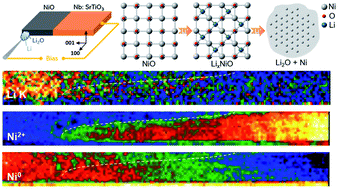Unraveling atomic-scale lithiation mechanisms in a NiO thin film electrode†
Abstract
An in-depth mechanistic understanding of the electrochemical lithiation process of nickel oxide (NiO) is both fundamentally interesting and technologically relevant for its potential applications. In this study, we utilize in situ transmission electron microscopy to unravel the intricate morphological features, charge state changes and lattice orientation relationships, leading to a comprehensive understanding on the conversion process in an epitaxially grown NiO thin film. Dynamic structural and chemical imaging, in combination with first-principles calculations, reveals the first direct visualization of the intermediate phase LixNiO, in which the interstitial sites are identified to be half occupied alternately, at the intercalation stage. A topotactic phase transition is identified, indexed as NiO (001)//Ni (111) by in situ electron diffraction. The kinetics of Li-ion transport can be affected by epitaxial strain and lattice defects inside the thin-film electrodes, in which disarranged structures at the boundary can promote ion diffusion, while compressive interfacial strain can have an opposite effect. These atomic-scale insights are of general importance in understanding conversion-type electrodes and guiding the design principle for viable conversion type electrode materials.



 Please wait while we load your content...
Please wait while we load your content...